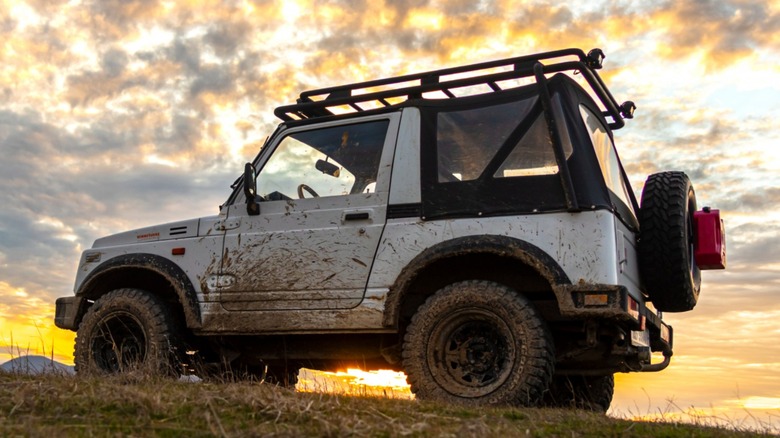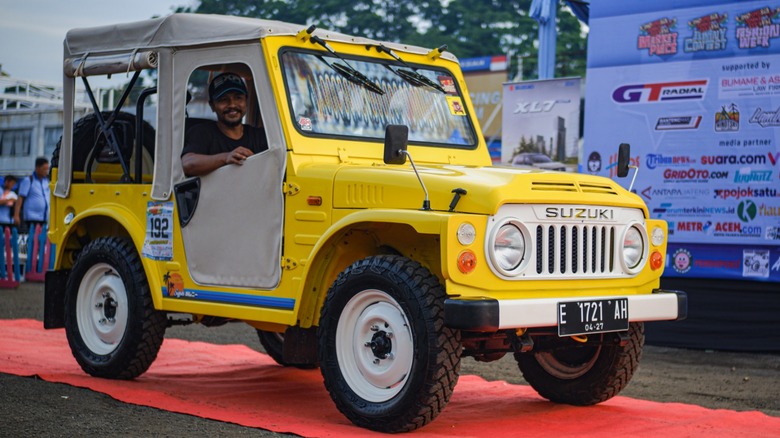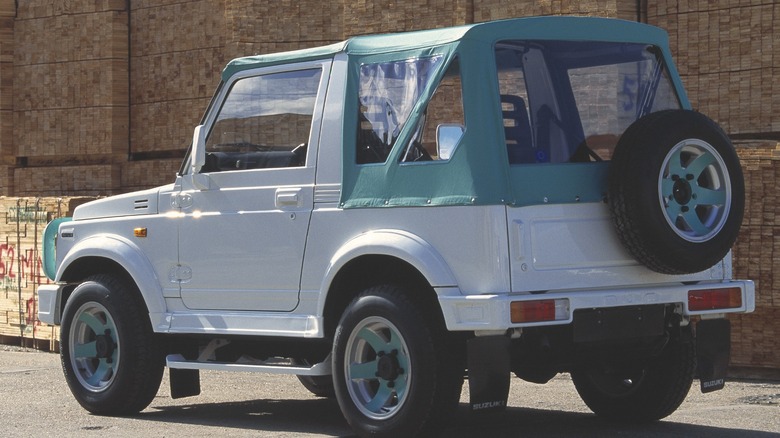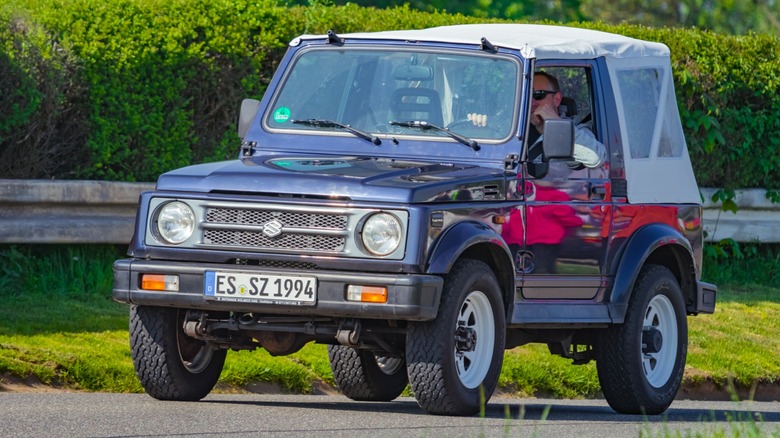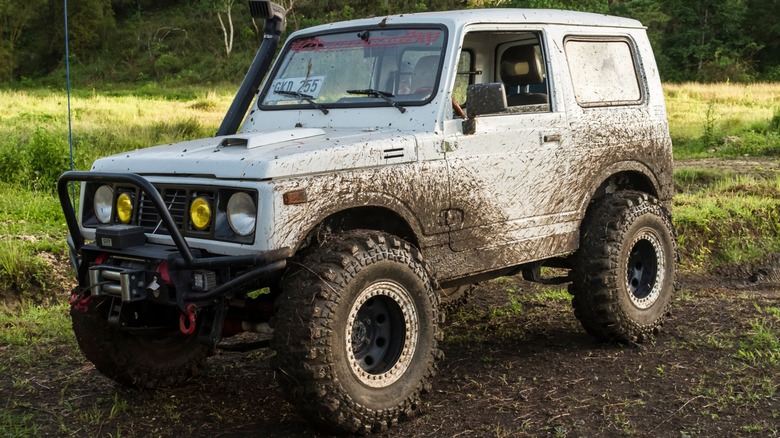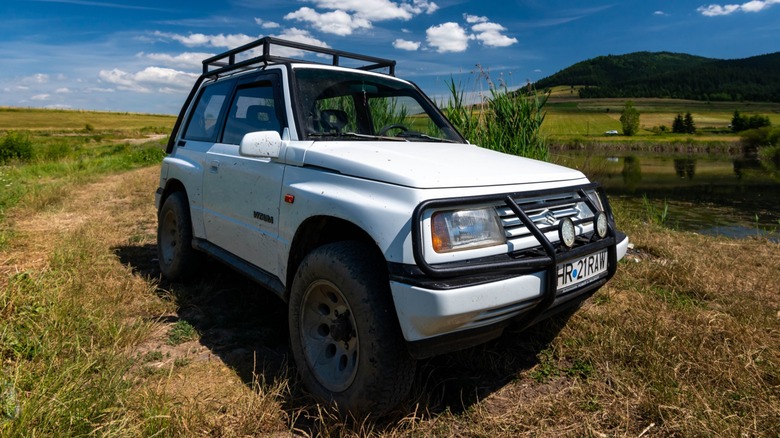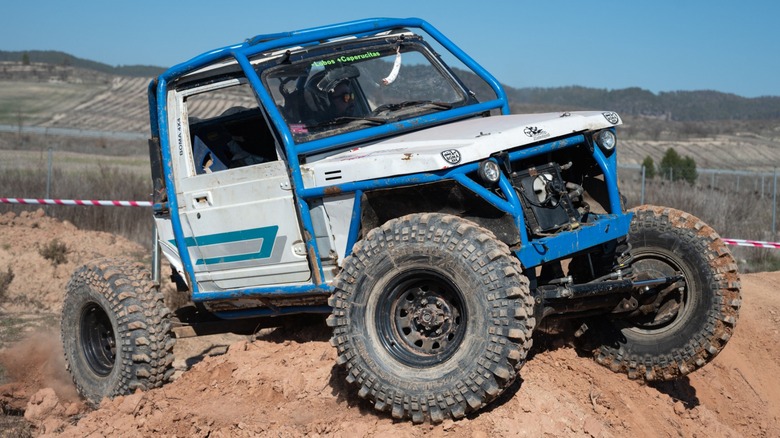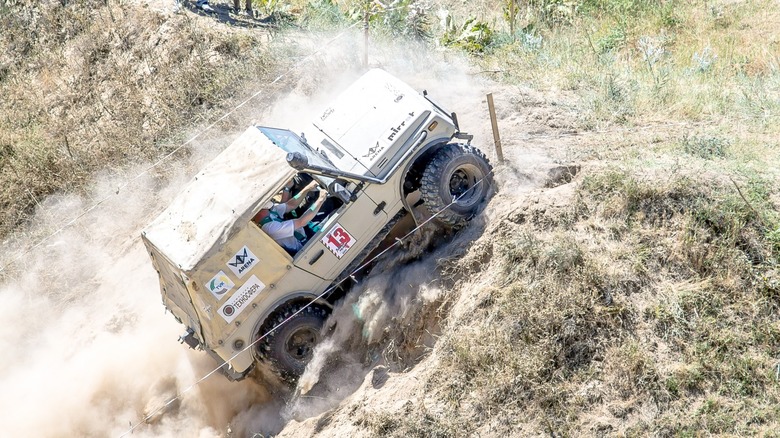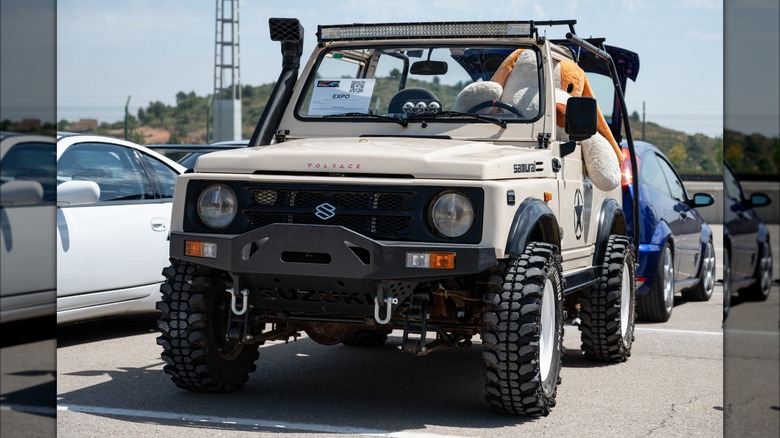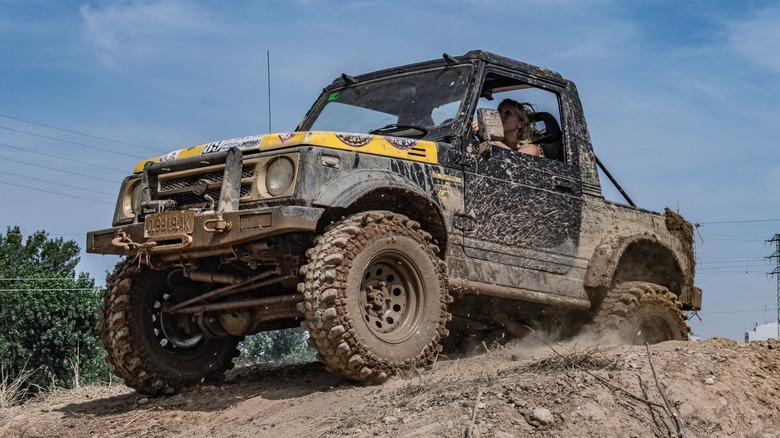Here's How The Suzuki Samurai Became So Popular In The 4x4 Community
The Suzuki Samurai first arrived on U.S. shores in 1986 to demonstrate that Suzuki was about more than just motorcycles. However, Americans' experience with Suzuki bikes established a good place from which to launch an automobile venture, as their motorcycles had long been known for being capable and reliable machines, particularly in off-road environments.
While Suzuki had been building two-wheelers since 1952, its first car came shortly after that in 1959. Although motorcycle sales began in the United States in 1962, its cars were far too small to be practical to attempt to sell in the American market, which is why it was more than two decades before the first Suzuki automobile made it over. Bringing in a small and light off-road truck proved to be a better way to break into the market than with a tiny and underpowered car that few Americans would buy.
With the Samurai came a sales network and more models, including the Swift, Aerio, and Kizashi. While Suzuki had a good run, the market proved to be too challenging, and the company pulled out of the United States in 2012. Regardless of how it went for Suzuki in the end, we were left with the remarkable Samurai, a tough little off-roader that continues to be cherished by enthusiasts across the country.
Samurai development
The Samurai was known as the Jimny elsewhere, and its development began long before it arrived at the Port of Los Angeles. Shortly after the idea of a consumer off-road vehicle began to take hold with models such as the Ford Bronco, the International Harvester Scout, the Land Rover, and the Toyota Land Cruiser, Suzuki released the Jimny. This was in 1970, and Suzuki was still a budding company trying to get a foothold in world markets. Suzuki found a shortcut to production by buying an existing model from Hopestar Motor Company, the Hopestar ON360, to be further developed and marketed by Suzuki.
This move proved successful and the little truck named Jimny became a good seller first in Japan and then in export markets. It found particular success in Australia, where 4x4 trucks were a way of life. The air-cooled 21 horsepower engine was upgraded to a 3-cylinder water-cooled 539cc unit. Exterior changes made by Suzuki modernized the little truck before a second generation came along in 1981, by which time Suzuki was a fully developed company ready for worldwide exports.
When Suzuki sent it to North America, the Jimny was powered by a 1.3L overhead-cam four-cylinder engine providing 63 horsepower and had been given an acceptable build quality and level of refinement for American consumers. It went on sale in 1986 as the Suzuki Samurai for $6,550.
Initial popularity
When the Samurai went on sale, it was thousands less costly than a Jeep Wrangler. With it came an advertising push with TV spots depicting the Samurai as a fun little unassuming car that was cute and approachable. Suzuki's plans were for the sales of 1,200 units per month. In reality, Americans bought 47,000 in the first year and sales reached 8,000 per month by the middle of 1988. In short, the Samurai was a runaway success.
While its Japanese competition often found its entry into the American market a long slow road to success, Suzuki's was nearly instantaneous. Rather than trying to convince American consumers of why an imported car would be a good choice over something built at home, Suzuki brought to the market something new and fun that was unlike anything else available at the time.
The New York Times reported at the time that Suzuki was intentionally avoiding advertising it with any hint of machismo. Instead, marketing materials focused on the fun aspects of the product and tried to entice buyers who wanted efficient vehicles without them being boring and uninspired. Billboards advertising ”27 laughs/city, 29 laughs/hwy” drove home that message. However, as good as things went in its early days, clouds were gathering on the horizon that would substantially alter the trail that the Samurai was traveling.
Controversy
While things were going gangbusters for the little Suzuki in its first few years, automotive journalists picked up copies of the vehicle for testing and review. Most dedicated automotive journalists, such as those from Car and Driver, walked away from their testing impressed, citing some shortcomings but generally reporting a positive impression of the Samurai. However, when Consumers Union, the publisher of Consumer Reports magazine at the time, bought one for independent testing, their reports came back with some huge red flags.
Consumer Reports uses its own labs and test tracks to evaluate new products. To remain independent and free from manufacturer influence, it does not accept cars from the manufacturers, opting instead to buy them outright for testing. After a couple of years of growing sales, Consumer Reports tested a 1988 Suzuki Samurai and published its findings. The report claimed that the Samurai was highly prone to rollover and determined it to be unsafe, giving it a Not Acceptable rating. However, 120,000 Samurais had already been sold and the findings received broad media coverage, causing alarm to owners and potential buyers of Samurais, killing sales overnight.
Legal wrangling
Suzuki was incensed at the report and would eventually file a lawsuit claiming defamation of its product as a result of a flawed testing regimen, although it would take years for that suit to wind through the legal system. In the meantime, government agencies from the United States, Great Britain, New Zealand, and others issued their own reports countering the findings of Consumer Reports, indicating the testing procedures were flawed. However, the damage to reputation was done and Suzuki filed a lawsuit for product defamation.
Suzuki asserted that Consumer Reports engineered the test intentionally to make it rollover. CNN published those accusations in 1997, in which Suzuki presented a written statement by a former employee saying he had heard an executive say, "If you don't find someone to roll this car, I will." However, for the most part, the damage was done. In 1987, Suzuki sold two Samurais for every Jeep Wrangler sold, but within a year after the report had been published, Suzuki sold less than 2,000.
Suzuki continued selling the Samurai into the 1990s and eventually thought the scandal was behind them until Consumer Reports published another story in 1996 reasserting their original findings. According to Suzuki, Consumer Reports appeared to relish in the lost business it had caused. A defamation suit against Consumer Reports was dismissed in 2000 by a federal judge but was overturned on appeal. Suzuki dropped the suit in 2004 after the parties came to an agreement where Consumer Reports would no longer refer to the original report and admitted that it may have used language that could be misconstrued in its findings.
Decline and replacement
Although sales fell sharply after 1988, Suzuki continued selling the Samurai in the United States until 1995. It did, however, continue selling the Jimny in other markets and it remains one of Suzuki's most popular models today, even setting sales records in Australia in 2022. Even before the Samurai controversy, Suzuki had been developing a slightly larger off-roader called the Sidekick, which debuted in 1989. This model had many technical improvements over the Samurai, including independent front suspension, a larger 1.6L engine, and a more refined interior.
Although it may have seemed to be a Samurai replacement when it first went on sale, it was meant to be sold as a larger alternative to the Samurai. However, it did serve as a de facto replacement for the Samurai in 1996 after that truck was discontinued in the United States, leaving the Sidekick as the only off-roader in its lineup. The Sidekick picked up the torch from the Samurai and continued to be offered, both as a Suzuki and a Chevrolet Tracker, well into the 2000s. Suzuki eventually changed this larger model's name to Vitara, which it retained until Suzuki left the market for good in 2012.
Samurai customization
While the Samurai in stock form is an excellent and capable little truck, it serves as an even better base to work with in creating a junior-sized trail monster. The range of customization is broad, including everything from small tweaks to the suspension to complete makeovers, creating jacked-up rock climbers with huge engines swapped in for the diminutive 4-cylinder. The only limiting factors are imagination and budget.
Several websites and forums are currently maintained with information and access to parts to maintain, restore, and modify a Samurai. One of the more comprehensive sites dedicated to off-road Suzukis in the United States is Zuki World Online, but it is far from the only one. Samurai fans engage each other in a lively conversation about their rides and share technical know-how through some dedicated forums such as Zuwharrie and dedicated sections of larger Suzuki forums found on Suzuki-Forums or Pirate 4x4. Another healthy Samurai information outlet is the 6,000+ follower Suzuki Samurai subreddit.
The best way to see how extreme some Samurai builds can get is, of course, on YouTube. You will find few channels dedicated solely to this one model, but there are many off-road channels featuring all manner of builds from fun trail riders to intense rock crawlers. What might be most surprising is how well these rigs perform using the original 1.3L engine, often with only a modest boost in power.
Feats of strength
Turning to the wide and wonderful world of YouTube, you can view some customized Samurai vehicles taking on unimaginable terrain, often going places that larger rigs will not attempt. While Suzuki Jimny models have found their way through extreme territory in far-flung parts of the world in places like Africa and Australia, it is when people start to turn wrenches and spend unreasonable amounts of money on modification when it gets truly interesting. This does not suggest that driving a bone stock Jimny through the Kalahari is less than compelling — it is just that making crazy custom builds tends to provide excellent entertainment.
An interesting competition shared by LebMotorsports demonstrates how the Samurai stacks up to the competition in this challenge between the little Suzuki and a Jeep Wrangler of similar vintage. Neither one is easily stopped.
The Fast Lane Cars put together a similar challenge using a completely stock condition Samurai and a lifted modern Jeep Wrangler. The Suzuki performs admirably in this David and Goliath matchup. Another YouTube video posted 17 years ago by a channel with just 371 subscribers shows a Samurai successfully tackling unbelievably deep mud. More surprising is that it is the most viewed Samurai video with 2.5 million views. TFLclassics takes its 1987 Samurai up a steep hill of loose terrain, proving huge tires and a giant engine are not critical for tackling extreme terrain — all you need is an old Suzuki.
Aftermarket parts support
Despite being out of production for decades –- the 2nd generation Jimny/Samurai, specifically –- and lacking an existing dealer network, Samurai owners have an ample supply of parts readily available today. For many of the most basic maintenance and replacement parts, neighborhood parts stores and online outlets will stock a good quantity. Brake pads, air filters, and more should be available and often in stock. Even many mechanical components can still be found from the major aftermarket producers. For example, Autozone lists the Samurai on its website and offers replacement parts such as an air conditioner compressor, radiator, and brake calipers.
For those who want to do something more than simply maintain their Samurai, other specialty manufacturers are keeping the parts supply lines running. Samurai Parts, Zuki Parts 4x4, and Suzuki Parts USA all offer parts specifically for the Samurai and other Suzuki models. Furthermore, most specialty off-road parts suppliers include the Samurai for everything from engine parts to suspension upgrades or soft tops. That is great for Samurai lovers because manufacturers will always make parts for these little trucks as long as people are willing to buy them.
40 years of Samurai
When it first arrived on American shores, nobody could have predicted what a runaway success the Suzuki Samurai would be. Even the manufacturer had much lower goals set compared to the actual sales figures. However, it should have been no surprise that an affordable and durable fun little off-roader would do well, especially given how much Americans spend on outdoor recreation of all kinds each year. With the vast spans of wilderness and unpaved terrain, this country offers the off-road enthusiast ample opportunity to get out and in the dirt. Even though the Samurai excels in getting to the remote villages of the world, it equally excels in providing a good time.
Being good at what it was built for is what has given the Samurai its staying power. Good Suzuki engineering and reliability is what has guaranteed its survival long after the sales pipeline dried up. Over the past decade, prices of classic cars have been a bit unpredictable but have still seen phenomenal growth. Furthermore, prices of vintage cars from the '80s are on the rise, especially as older cars become too expensive for the average buyer. This makes Samurai ownership an excellent proposition, financially speaking.
Regardless, the free-spirited and fun-driving nature of the Samurai is distilled in the spirit of the truck and fans who appreciate this will keep them going for years to come.
